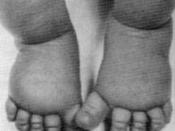TURNER'S SYNDROME
Turner syndrome, also known as Turner's Syndrome, is a chromosomal disorder resulting in a syndrome characterized by specific dysmorphic features (short stature) and organ malformations. All humans have 23 pairs of chromosomes which contain all of our genetic information. Men are different from women because they have on pair of chromosomes consisting of a single "X" and a single "Y" chromosome. Women however normally have two X chromosomes. Unlike females who don't have Turner's Syndrome who have two X chromosomes, those with Turner's Syndrome are missing or have a damaged X chromosome.
It is impossible for a male to have Turner's Syndrome because without an X chromosome, a male fetus cannot survive. Y chromosomes cannot function on there own. Single X chromosomes can survive, but the resulting child is a girl with Turner Syndrome.
Turner's syndrome is a genetic disorder of females characterized by the complete or partial absence of one of the two X chromosomes. The syndrome occurs in about 1 per 3,000 female births. About 98% of pregnancies abort spontaneiously and approximately 10% of fetuses from pregnancies that have spontaneously aborted have Turner's Syndrome. The newborns that are affected typically are below average in length, with swollen hands and feet and loose folds of skin (also known as webbing) on the neck. Common signs in older children and adults who have Turner's Syndrome include short stature, a low hairline, low-set ears, a wide chest, underdeveloped nails, pigmented moles, bending out of the elbows, puffy hands and feet, and kidney and cardiovascular abnormalities. Short stature is almost always found in Turner's Syndrome, the cause of which is multifactorial, including intrauterine growth retardation, gradual decline in height velocity in childhood, absence of pubertal growth spurt , and to end organ resistance resulting...


